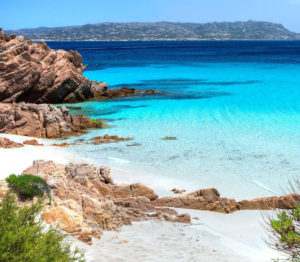The Monthly Read: Under a Sardinian Sky
by Mary Drake –
Let’s take a trip to Italy: A review of Under a Sardinian Sky by Sara Alexander
Under a Sardinian Sky by Sara Alexander
Kensington (April 25, 2017), 321 pages
I look out the window at the snow gradually but persistently falling and starting to accumulate, I try to resist California dreaming. Hunkering down for another long western New York winter, I may have subconsciously chosen a book about white sand beaches and turquoise oceans in a warm exotic place—like Sardinia.
Wait. Where is Sardinia exactly? Don’t feel bad, I wasn’t sure either when I began reading Under a Sardinian Sky, by Sara Alexander. Sardinia is the second-largest island in the archipelago off the coast of Italy. Situated in the Mediterranean, it is sheltered by Spain to the west, Italy to the east, and Africa to the south, which is why its long, turbulent history is marked with Roman, Arab, and Spanish influences.
Alexander chose Sardinia as the setting for this 321-page historical romance about a native Sardinian woman and an American army Lieutenant who fall in love after WWII against all odds. Carmela is already engaged to Franco, son of a relatively prosperous family in their town of Simeus, a village so small it has only two telephones. Lieutenant Joe Kavanaugh is stationed at a nearby army base but has a wife and baby back in the States. Ostensibly, Carmela and Joe Kavanagh have a working relationship. She has taught herself English and is hired by him to translate as he tries to purchase land from native farmers, for Army purposes that are never made quite clear. She also teaches him about facets of the culture. When a rural farmer insists that Kavanagh accept a piece of bread with a thick, cheesy spread alive with maggots, Carmela tells Kavanagh, in English so that the farmer won’t understand, that he must eat it, since it is something the farmer is famous for. It turns out to be “sublime.” Later, during a lavish meal in the capital, Kavanagh tries to do business over dinner, but Carmela tells him, “Joe, we don’t speak of money right away. It’s not the Sardinian way.”
The novel is structured as a story within a story, since Carmela is first introduced in the prologue by her niece Mina who obsesses about solving the mystery of what happened to her aunt Carmela when she went missing all those years ago. To this day, no one talks about it. The body of the book then reverts to Carmela in the 1950s. Readers who are fond of novels with a lot of character development will enjoy getting to know all the thoughts and feelings that motivate Carmela. However, sometimes it’s a little hard not to become impatient with the extent of her internal debating. Yes, it’s a hard choice to renege on her promise to marry Franco, especially when he becomes violent. But Carmela spends excessive amounts of time convincing herself either to go with Kavanagh or stay with Franco. And although we’re repeatedly told that she is a strong, brave Sardinian woman, she seems to spend a lot of time crying.
Interwoven in this tale of thwarted love are lavish descriptions of 1950’s Sardinian food, culture, geography, even feast days and games, as well as the customs and celebrations inherent in each season. On the eve of All Soul’s Day, what we call Halloween, the women of the house always gather in the kitchen to shell almonds and hazelnuts, which, along with dried figs and plums, provide their offerings to the spirits of their ancestors who will visit that night. Food is closely associated with every season.
And who knew Sardinians celebrate Mardi Gras, what they call Martedi Grasso. In an enormous copper cauldron they cook steaming bean stew fragrant with pork and wild fennel and in another vat, sugar melts in preparation for making almond and hazelnut brittle. In the town square, there is always a poetry competition and later, a wild parade where hooded men dance while “bowing under the weight of at least two dozen metal bells attached to their backs, on sheepskins that wrapped around their bodies.” These are the frightening Mamuthones:
It’s a kind of scary version of the Mummers parade in Philadelphia, but the tradition goes back much further, to pagan times.
The island of Sardinia is portrayed as nothing if not paradise, so it’s no wonder that Joe Kavanagh’s first confession to Carmela is that he’s fallen in love—with the island. It seems filled with “wide, rugged, deserted beaches” and “white sandy shores stretching as far as the eye could see.” However, readers must be patient through these long descriptions of scenery before finding out, at the very end, what Mina finally discovers happened to her aunt all those years ago.
Perhaps because this is Sara Alexander’s first novel as well as her second career—her first being acting—the novel seems somewhat overwritten, although it is definitely atmospheric and provides great escapism. In an interview Alexander stated that her acting background requires that she “slip into the skins of others,” a talent that is useful in writing. Also, the romantic nature of the novel means that Carmela and Kavanagh are not really developed as people much beyond their love for each other, and both can come off seeming a little too perfect. However, Alexander comes from a Sardinian family and considers Sardinia her homeland, so it is a natural setting for her book, and she plans to write two more which will also be set in Italy.
